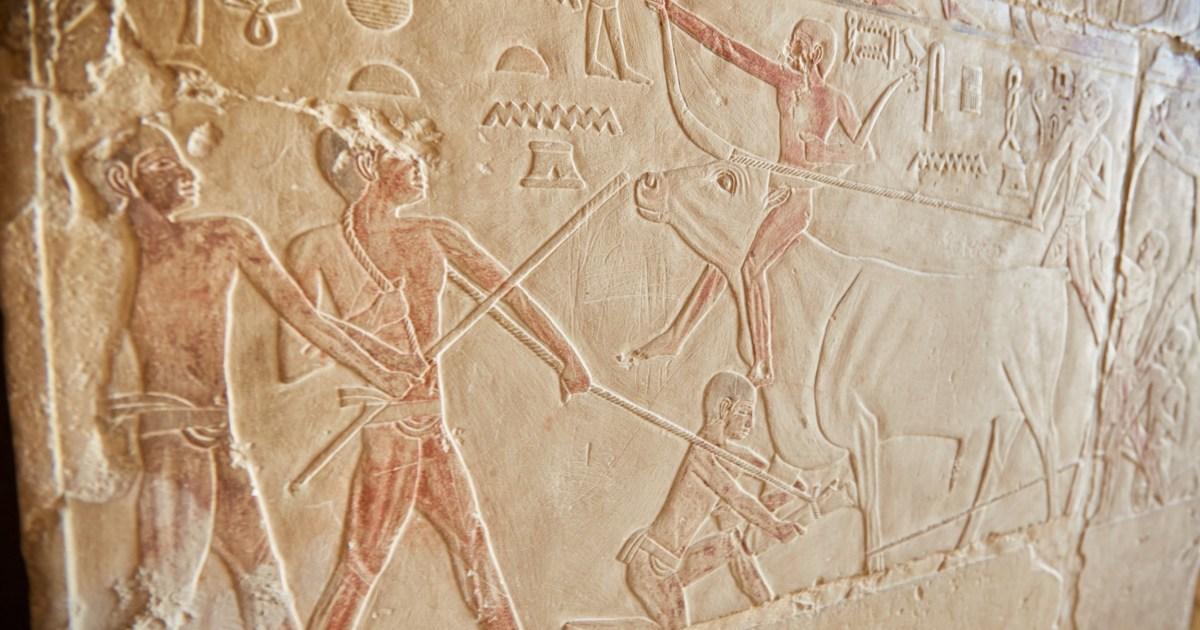World
Rare 4,000-Year-Old Limestone Carving Stolen from Egyptian Tomb

A significant limestone carving, estimated to be over 4,000 years old, has been reported missing from the ancient tomb of Khentika in Egypt’s renowned Saqqara necropolis. This theft is the latest in a troubling series of incidents involving the loss of valuable artifacts from the region, raising alarms about security measures protecting Egypt’s heritage.
The limestone piece, which dates back to approximately 2700 BC and belongs to the sixth dynasty of the Old Kingdom, was discovered to be missing by a British archaeological team working in the tomb in May. The tomb, which had remained unopened since 2019, contains reliefs that depict daily life in ancient Egypt, highlighting the cultural and historical significance of the artwork.
According to archaeologist Ali Abu Deshish, the theft has been described as a “catastrophe,” particularly as the stone was cut directly from the wall of the tomb. This incident follows closely on the heels of another theft, in which a gold bracelet was taken from the Egyptian Museum before being melted down and sold.
The previous theft occurred on September 9, 2023, when Pharaoh Amenemope‘s lapis lazuli bead jewelry was stolen by a restoration specialist from the museum. This item, valued at approximately £2,819, passed through several dealers before being destroyed. Four suspects, including the restoration specialist, have been arrested, and investigations are ongoing.
In response to these incidents, renowned Egyptian archaeologist Monica Hanna has called for improved security measures to safeguard Egypt’s cultural artifacts. She emphasized that there were no security cameras in the museum’s lab where the most recent theft occurred, highlighting significant vulnerabilities in the current security system.
The Saqqara necropolis, a UNESCO World Heritage site, holds a wealth of archaeological treasures. It has been a focal point for researchers and historians since its discovery in the 1950s. The loss of the limestone carving not only diminishes the site’s integrity but also raises concerns about the broader implications for the preservation of Egypt’s historical artifacts.
In a related note, the British Museum recently faced its own security crisis when an employee was dismissed over missing items, including gold, jewelry, and semi-precious stones. Museum director Hartwig Fischer acknowledged the situation, committing to enhance security protocols and recover stolen artifacts.
As the world watches, the urgency to protect Egypt’s invaluable cultural heritage continues to mount. The theft of the limestone carving from the tomb of Khentika serves as a stark reminder of the challenges faced in preserving history against the backdrop of modern-day vulnerabilities.
-

 Health1 month ago
Health1 month agoFiona Phillips’ Husband Shares Heartfelt Update on Her Alzheimer’s Journey
-

 World1 month ago
World1 month agoCole Palmer’s Cryptic Message to Kobbie Mainoo Following Loan Talks
-

 Entertainment3 months ago
Entertainment3 months agoLove Island Star Toni Laite’s Mother Expresses Disappointment Over Coupling Decision
-

 Entertainment2 months ago
Entertainment2 months agoMajor Cast Changes at Coronation Street: Exits and Returns in 2025
-

 World2 weeks ago
World2 weeks agoMassive Sinkhole Opens in Bangkok, Swallowing Cars and Causing Chaos
-

 Entertainment2 months ago
Entertainment2 months agoMasterChef Faces Turmoil as Tom Kerridge Withdraws from Hosting Deal
-

 World3 weeks ago
World3 weeks agoMichelle Tsiakkas Opens Up About Jamie Borthwick Before BBC Exit
-

 Lifestyle2 months ago
Lifestyle2 months agoEngland Flags Spark Controversy This Summer: A Cultural Debate
-

 Entertainment3 months ago
Entertainment3 months agoWoman Transforms Life with Boot Camp, Losing Nearly 9 Pounds in a Week
-

 Entertainment3 months ago
Entertainment3 months agoColeen Nolan Reflects on Family Tragedy and Reconciliation
-

 World1 month ago
World1 month agoCoronation Street’s Asha Alahan Faces Heartbreaking Assault
-

 Science3 months ago
Science3 months agoAstronomers Discover Giant Exoplanet in Star’s Dusty Surroundings









